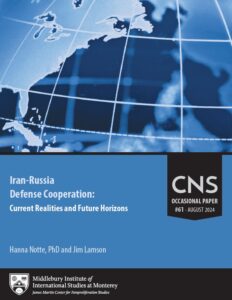August 6, 2024
Hanna Notte and Jim Lamson
Executive Summary
Key Takeaways
(1) Big leap forward. Against the backdrop of Russia’s war against Ukraine, the Iran-Russia defense relationship has moved past the previous client-patron dynamic, with Iran emerging as an important provider of defense technology to Russia. Bilateral cooperation has expanded both in degree and in kind. In pre-existing areas of cooperation—such as electronic warfare, space, cyberspace, and military-to-military contacts—engagement has accelerated or deepened. Since 2022, Iran and Russia have also cooperated in entirely new areas. Those have included Iran’s provision of uncrewed aerial vehicles (UAVs), UAV production technology, and UAV training to Russia, alongside Iran’s multifaceted support for Russia’s ground war and assistance with expertise on evading sanctions.
(2) The gloves are off. Since February 2022, what were historically key drivers of defense cooperation—a shared animosity toward the United States and the international order it promotes (including in the Middle East), and each side’s interest in military technology that the other side can offer—have increased in importance. Key constraints—Russia’s susceptibility to U.S. or Western pressure, causing it to limit cooperation with Iran; Russian concerns with adhering to nonproliferation norms and export control regimes; Russian reputational concerns over collaborating with Iran; Iran’s inability to pay for Russian technology; or historical mistrust—have become less relevant with Moscow’s growing dependence on Iran and its increased enmity toward the United States and Europe.
(3) Growing institutionalization. Amid a general increase in numbers of mutual visits and high-level engagements among military and defense officials, Iran and Russia have taken steps to further institutionalize their defense relationship. Those have included work on a new strategic cooperation agreement to replace the one from 2001, forays into joint production of some weapon systems, and joint efforts to develop the International North-South Transport Corridor and other infrastructure that should provide a further boost to defense cooperation.
(4) Thinking about the future in three steps. We propose a three-step methodology to think through the contours of bilateral defense cooperation over the next three to five years. It involves a) extrapolating from current trend lines, drivers, and constraints; b) drawing up inventories of future military needs for each country and identifying the areas in which the other country could help meet those needs; and c) accounting for potential high-impact scenarios and developments that may trigger dramatic shifts in cooperation. The latter include various scenarios of war in the Middle East, the end of Russia’s military campaign against Ukraine, and regime change in either Russia or Iran.
(5) Neither a transactional relationship nor a military alliance. Present trend lines and drivers suggest that the relationship is no longer purely transactional and will probably not lapse back into the patron-client dynamic that characterized it prior to 2022, even once the war in Ukraine ends. Iran and Russia each have specific military-technical needs that the other might help meet. That said, beyond Russia’s campaign against Ukraine, Iranian needs from Russia will be greater than Russian needs for advanced technology from Iran. Other constraints—chiefly both countries’ challenges in procuring advanced components because of sanctions, Russia’s aversion to antagonizing the Gulf Arab states, and Russia’s enduring technological superiority in key areas—will also likely continue to act as brakes on the defense relationship, precluding it from developing into a full-fledged military alliance.

